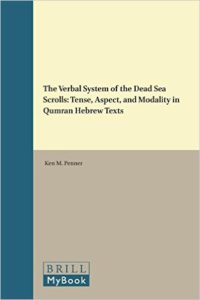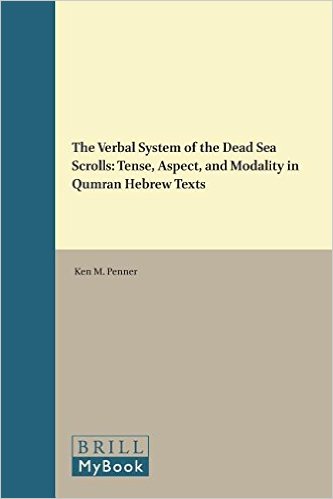 The Verbal System of the Dead Sea Scrolls: Tense, Aspect, and Modality in Qumran Hebrew Texts, by Ken M. Penner (Brill, 2015), 228 pages.
The Verbal System of the Dead Sea Scrolls: Tense, Aspect, and Modality in Qumran Hebrew Texts, by Ken M. Penner (Brill, 2015), 228 pages.
Ken Penner tackles an important but neglected area of study: the morphological value of Hebrew verbs in the Dead Sea Scrolls. That is, are the Hebrew verb tenses in the DSS aspect-, mode-, or time-prominent?
He introduces the subject by noting the basic ideas that biblical Hebrew is aspect-prominent, while Mishnaic Hebrew is time-prominent, but also that even these conclusions are disputed. Nevertheless, if these ideas are roughly correct, then the Hebrew of the DSS may play an important transitional role for the semantic value of Hebrew verbs. Thus, “It is the question of the semantics of the verb forms in the literature of this intervening period, witnessed by the Hebrew writings from Qumran, that the present study addresses. More specifically, this is a synchronic study that seeks to discover which of the categories (tense, aspect, or mood) was most prominent in Qumran Hebrew” (4).
The first chapter surveys standard understandings of tense, aspect, and modality, and then examines previous studies of Qumran Hebrew. He demonstrates the lack of consensus on the value of the Hebrew verb in the DSS, which provides the basis for the need for further study.
The second chapter lays out his methodology. Penner studied each verbal form in 1QS, 1QSa, 1QSb, CD, 1QM, the Pesharim, 1QHa, 4QMMT, and 11QT. He approached them empirically and tabulated the semantic function of each verb in context, then looked for any statistically significant correlations between the verb tenses and semantic values.
The third chapter includes the data, compiled into color computer graphs. He concludes that, with the exception of 4QMMT, the verbs in the DSS encode tense and modality much more than aspect (156). His hypothesis accounts for about 92% of the verbs in the corpus and 98% of verbs in prose independent clauses.
Penner then applies his findings to two exegetical problems in the DSS, whether salvation in the Hodayot is present or future and the historical period of two events in the pesharim. The two events are the five yiqtols in 1QpHab 10:3–5; 11:14; and 12:5 with the Wicked Priest as the object, and whether the Lion of Wrath of Pesher Nahum 3–4 I was from the implied author’s past, present, or future. He applies his understanding of qatals to be generally past and yiqtols to be almost always future to these issues exegetically in an attempt to further the discussion from a linguistic perspective.
Evaluation
Penner’s work is useful, innovative, and will certainly be applied to the exegetical problems he discusses, among others. His statistical model seems to bring a kind of objectivity to the study, although in reality (as everyone would admit), statistical models are never perfect. Moreover, the soundness of his model will be difficult to evaluate for those who do not have sophisticated education in statistical methods.
Another issue is with Penner’s charting of the data. When he lays out his data in chapter three, he cannot possibly justify all of his choices regarding the semantic value of each verb. Thus, the biggest problem with this work is the non-verifiability of his thesis. Unless one were to do the exact same work that Penner has done and tabulate the semantic value of every verb in these DSS, there is no way to compare results. While surely Penner is capable of making measured judgments, I question whether scholars will be happy to “take his word for it” on the data.
Probably the most useful aspect of this work is that it provides a thesis to test against one’s own reading in the DSS. If we keep Penner’s thesis in mind, translating DSS texts might be easier since we can approach verbs with a general sense for what time the verb encodes. In doing so, we can hopefully gain a better understanding of the DSS Hebrew inductively.
Preview or buy Penner’s book here.


